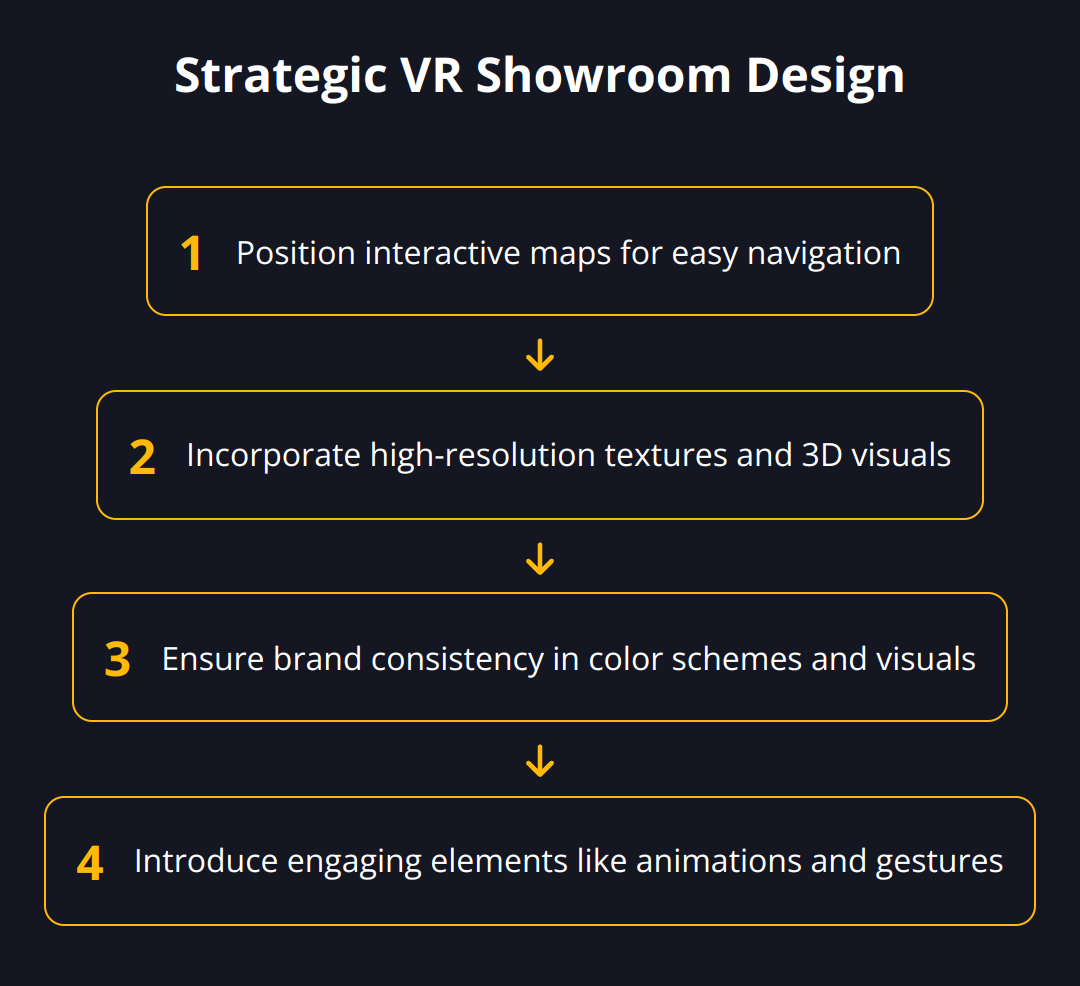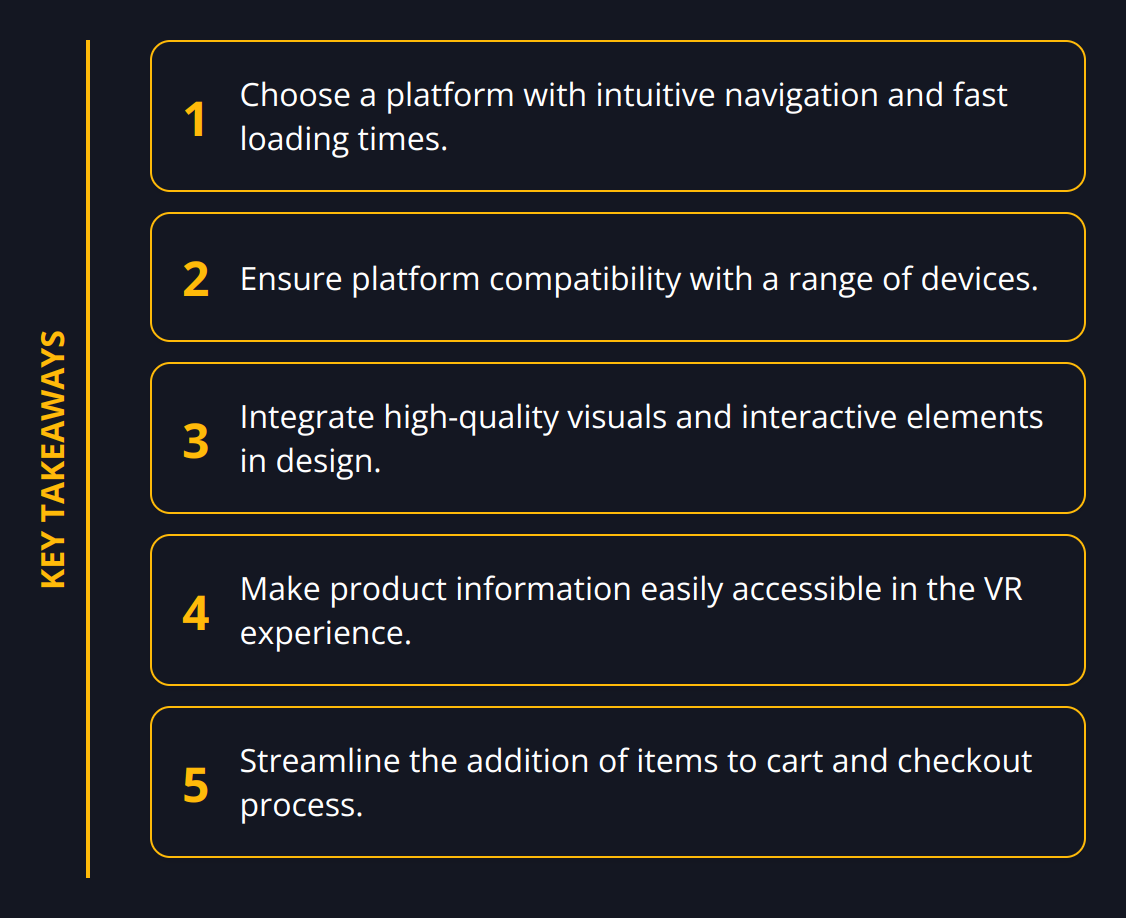We at newroom connect understand that virtual reality is transforming the way businesses showcase products and engage with customers. Setting up a cloud-based VR showroom can redefine your brand’s digital presence.
Identifying the perfect platform, crafting an inviting virtual space, and merging e-commerce capabilities are pivotal steps. Here, we’ll guide you through these essential phases to create an immersive and interactive virtual environment that resonates with your audience.
Choosing Your VR Platform
The backbone of any cloud-based VR showroom hinges on selecting the right platform. It’s more than just picking the most popular or expensive option; it’s about finding a platform that aligns with both your technical requirements and business goals. The ideal platform will be robust yet user-friendly, cost-effective, and come with reliable support.
When scouting for platforms, consider how it integrates with your existing systems. Compatibility is key to a seamless experience. Look for platforms that support a wide range of devices, ensuring your showroom is accessible regardless of whether your customers are on a smartphone or donning a high-end VR headset. A smooth cross-device experience leads to broader reach and customer satisfaction.
Next up is the user experience. Your showroom should be the digital equivalent of rolling out the red carpet. Key questions include: Is navigation intuitive? Are loading times swift? Is the interface clean and uncluttered? Complexity can be the enemy of engagement. Your audience should move through your VR space feeling intrigued and empowered, not frustrated.
Taking a cogent look at the platform’s e-commerce integration capabilities is also non-negotiable if your end goal is sales conversion. Users appreciate direct and easy access to purchase options as part of the virtual exploration process. Platforms that enable a streamlined pathway from viewing to buying will undoubtedly increase customer engagement and your bottom line.
Pricing models and support should not be glossed over. They vary widely and can spell the difference between a scalable solution and a financial pitfall. Some platforms operate on a subscription basis, others on a pay-as-you-go scheme. Consider long-term costs and the scalability of each option. Solid customer support can significantly reduce downtime, so prioritize platforms with a reputation for responsiveness and robust help resources.


Here are some actionables:
-
Integrate virtual reality in education via platforms with robust e-commerce functionality
-
Opt for platforms offering detailed analytics; data is your friend when it comes to understanding customer interactions
-
Demand high-quality customer support; it’s indispensable for troubleshooting and ensuring uptime
Lastly, the platform you choose must grow with you. A system that can’t scale as your business evolves will become a hindrance. Aim for a solution that promises updates, new features, and compatibility with future technologies. Remember, your cloud-based VR showroom is an investment into your brand’s future. Make it count.
Design Your VR Showroom
Crafting a virtual showroom is like constructing a building; it requires meticulous planning, an eye for design, and an unwavering focus on user engagement. A well-thought-out virtual space not only showcases your products in the best light but also creates an enticing environment that the visitors would love to explore and return to. Here’s how to set the stage for your VR showcase to be a showstopper.
Planning the Layout and Navigation
The architecture of your virtual space is crucial. The flow should be logical, with clear pathways that guide users to your featured products. Overcomplicated layouts will confuse visitors, so keep it straightforward. A layout that mirrors a natural retail journey can boost engagement and intuitiveness. Remember, you have mere seconds to grab attention, so make the entrance captivating and the journey through the space reflective of your brand story.
Highly detailed, user-friendly signage can direct visitors effortlessly. Interactive maps or directory boards help users orient themselves without the need for backtracking. Enhancing the user’s autonomy in the VR space not only improves satisfaction but can also lead to longer visit times, which is pivotal in the path to purchase.
Selecting Visuals and Interactive Elements
Statistics reveal that online shoppers who engage with a 3D product are 144% more likely to add it to cart. Incorporating high-quality visuals and 3D models is therefore not just advisable; it’s vital. Your VR showroom should provide a richer experience than flat images on a webpage. Users should be able to interact with your products, viewing different angles and variations, simulating a hands-on encounter as closely as possible.
Additionally, involving interactive elements that offer more than clicks—think gestures, voice commands, or head movements—creates a deeper level of interaction. These can trigger animations, product stories, or additional layers of detail about your offerings.

Ensuring Brand Consistency in Design
Align every aspect of your VR showroom with your brand identity. Color schemes, lighting, and even the virtual materials used for furniture and walls should mirror your physical stores or marketing materials. This uniformity reinforces brand recognition and loyalty. After all, your virtual showroom is an extension of your brand; it should feel like walking into one of your branded spaces in the real world.
The implementation of your brand logo is obvious, but think beyond that. Include your brand’s ethos in every element. If sustainability is part of your brand’s story, then convey that story through the design and elements used in your VR showroom.

Strategic Tips for Showroom Success
-
Smart Layout: Introduce hot spots for new arrivals to catch user interest immediately.
-
Quality Visuals: Invest in high-resolution textures for a lifelike product display.
-
Engaging Elements: Utilize animations to demonstrate product features and benefits.
-
Feedback Loop: Have a system in place to gather user feedback for continuous improvement.
In summary, designing your virtual showroom should focus on providing an engaging, interactive, and seamless brand experience. Following the above guidelines, you can create a space that not only showcases your products but also entices customers to explore and connect with your brand on a deeper level. Keep your audience at the heart of the design process, and success will follow.
Enhancing Virtual Interaction with Products
Enriching your virtual reality showroom with detailed product information and seamless e-commerce functions is a game-changer for customer engagement and sales conversion. Here’s a practical guide to making your products shine and turning virtual interest into real-world purchases.
Embedding product details directly into the VR experience is revolutionary. As visitors explore your showroom, they should be able to access product specifications with ease. Implement clickable areas or interactive hotspots on each product, leading to a rich dialogue box filled with all necessary details – dimensions, materials, price, and more. This transparency builds trust and educates customers, enabling informed purchase decisions.
Now, let’s revolutionize the trial process. Virtual product demos and trials should mimic the in-store experience. For products like furniture or electronics, leveraging augmented reality within your VR allows customers to visualize items in their own space. Apparel and accessory brands can benefit from virtual fitting rooms powered by avatars. These innovative trials aren’t just impressive; they significantly boost confidence in purchase decisions — fewer doubts, fewer returns.
The pinnacle of a VR showroom’s success lies in integrating the shopping cart and checkout processes. E-commerce is more than a feature; it’s the heartbeat of your commercial success. Ensure that adding items to the cart is a swift and intuitive process. The fewer clicks, the better. Seamless integration with widely used payment gateways reassures users and shortens the distance between liking and buying. The goal is to replicate the simplicity of online shopping carts, combined with the immersive experience of VR.

Remember, as much as the showroom is about immersion, it’s ultimately a sales funnel. Consider these pointers to steer users to purchase:
-
Make product information accessible with a single action.
-
Offer virtual trials that closely replicate real-world experiences.
-
Ensure a swift, also intuitive transition from interest to purchase.
In conclusion, integrating these e-commerce functions into your VR showroom is not an afterthought but a vital part of the design. Doing it right can mean the difference between a showroom that’s merely a novelty and one that’s a robust revenue generator. Keep refining these elements based on customer feedback and analytics for continuous improvements and increased sales.
Wrapping Up
Establishing a cloud-based VR showroom heralds a new era for customer interaction and product display. We’ve walked through the pivotal steps: choosing the right VR platform, designing a user-focused virtual space, and weaving e-commerce seamlessly into the experience.

A well-designed VR showroom is more than just a collection of 3D models; it’s a comprehensive platform that tells your brand story, enhances customer experience, and streamlines the path from exploration to purchase. The crucial aspects we’ve highlighted are the foundation of a virtual space that’s both inviting and commercially viable.
The emphasis throughout should be on the user experience. It’s not only about how the virtual space looks but how customers feel when interacting with it. The intuitive navigation, high-quality visuals, and easy transaction processes are testament to this focus.
However, technology and customer expectations are always evolving. Continuous innovation and regular upkeep of your VR showroom will keep it at the forefront of virtual engagement. Use analytics to understand customer behavior, collect feedback for improvements, and keep your showroom on the cutting edge of technology.
At newroom connect, we take pride in our software platform that paves the way for immersive virtual experiences. The ease with which businesses can set up their showrooms is matched by the sophistication and reliability of our tool. With expert support and various pricing options, we stand ready to assist companies in embracing the digital transformation.
In conclusion, the journey to creating an impressive cloud-based VR showroom is demanding but deeply rewarding. It’s a significant step toward a future where digital is the new reality for showcasing products, engaging with customers, and driving sales. BindingFlags to the power of virtual spaces and make your mark in a boundless digital landscape with newroom connect.
-
Right platform choice
-
Design that captivates
-
E-commerce efficiency
-
Commitment to ongoing refinement
By adhering to these principles, your business can offer an unforgettable virtual experience that resonates with your audience and bolsters your brand. Embrace the limitless possibilities of virtual reality with newroom connect, your partner in digital excellence.


